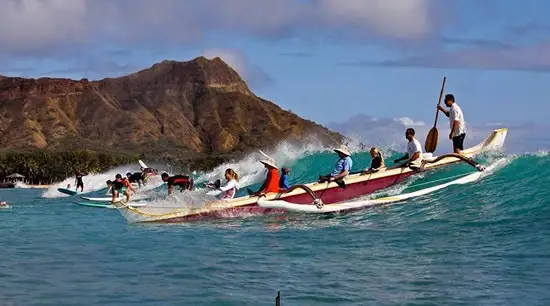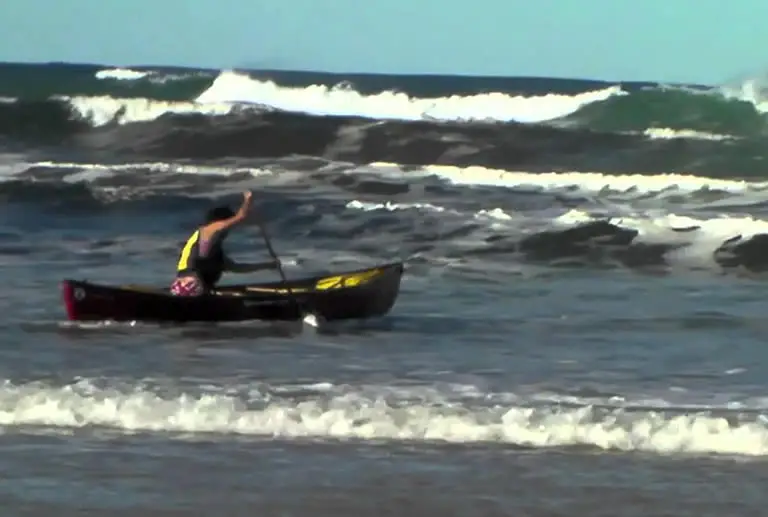Contents
A Guide To The Ocean Canoe
As we covered previously in in our canoe buyer’s guide canoes do not come as a one-fits-all boat.
There are different designs of canoe that have hulls which are best suited to certain marine environments and weather conditions.
The basic canoe design, that has been used for thousands of years, is best suited to calm inland waters not the ocean. But, as is the case with many other inland watercraft, this does not necessarily mean you can’t take a canoe out into the ocean.
Can you canoe in the ocean?
Yes, most canoes can be used in the ocean but only if the weather is calm and you stay close to the shoreline.
A shallow-v outrigger canoe it the best choice as it can take to the ocean.
It performs better in more challenging conditions because it is more buoyant and has a design that enables it to cut through waves and ride choppy water.
Canoes that are best suited to ocean waters will have a hull design that allows them to cut through water, deflect waves and stay stable even in jostling choppy water.
So you may well be wondering of there is such a thing as an ocean canoe.
As I mentioned previously any type of canoe can be taken to sea but only under optimal conditions.
Just as a Jon boat finds it difficult to handle rough water and will probably sink in very challenging large ocean waves (see our article can Jon boats go in the ocean), so too will canoeists get into trouble if they find themselves far out in ocean waters.
If the weather turns bad, the wind picks up and the waves start rocking a canoe it can be difficult to stay afloat.
The different types of canoes & their suitability for ocean use
I won’t go into the different hull designs associated with canoes in this article. If you want a better understanding of each of the hull types and what they are designed to help the canoeist achieve read this article.
Here I will simply point out the worst types of canoes for ocean use and the best ocean canoe design if you truly want to take to sea waters.
Canoes that are unsuitable for ocean use – especially in challenging conditions:
- Flat bottom canoes.
- Round bottom canoes.
- Canoes with straight sides.
Canoes that are suitable for ocean use:
- Canoes with a shallow arch bottom (also called just called an arch bottom).
- Canoes with a shallow-v bottom (probably the most effective for ocean use).
- Canoes with flared sides (and the appropriate bottom).
- Outrigger canoes.
Examining The Best Hull Design For An Ocean Canoe
If you plan to take to the ocean in a canoe then we would advise you to use one that has a shallow-v arch bottom and flared sides.
Let’s take a look at why this particular hull design offers you the best protection against challenging water ocean water conditions.
Shallow-v with flared sides is the best design for an ocean canoe
The shallow-v arch bottom gives the canoe a deeper draft than the other types. This allows the boat to sit deeper in the water for more stability in swell and waves.
For more about shallow draft and deep draft read this.
Flared sides on a canoe will help it to deflect waves so it is less likely to take on water and it will move more smoothly through the waves.
Of all the canoe types the flat-bottomed, straight-sided, recreational canoe is the worst to use in the ocean.
Do not take a flat bottom canoe with straight sides onto the ocean unless the water is completely calm and you know the weather will remain fair for the time you are out there.
If you want to know why a flat-bottomed canoe should not be used in the ocean read this.
Outriggers add an extra level of safety & stability to any ocean canoe
The typical Native American canoes are brought to mind when most people think of a primitive canoe, and for good reason.
This design was so successful that canoes have changed very little since the American Nations used them before the formation of modern America.
However, these canoes were rarely used in open ocean waters.
Ancient canoes were mostly transportation and fishing boats that were used on inland waterways where the body of water was calm, being protected from strong winds.
These inland bodies of water were also usually fairly shallow.
As canoes have changed very little in design since those days it stands to reason that modern canoes are also best suited to the same uses and environments.
Even ancient cultures, using traditional canoes, understood that a canoe used on the ocean needs extra buoyancy. Hence the introduction of the outrigger canoe.

Outrigger canoes fair much better in ocean conditions than other types of canoe simply because they have extra buoyancy and stability.
Outrigger canoes get their name from the fact that they have one or two additional floatation devices attached to their sides, called outriggers.
The floatation devices, or outriggers, offer a canoe much more buoyancy because of their design.
In addition an outrigger will be made from a construction material which is naturally buoyant.
Outriggers are made from plastic or inflatable materials and are attached to the side of a boat via hollow poles usually made from plastic or lightweight aluminum.
Outriggers are attached to each side of the canoe and jut out from the boat to stabilize it in the water.
Should a wave hit the the boat from the side the outrigger on the other side will stop the boat from tipping.
Although it will vary depending on the size of the canoe it is fitted to, an average outrigger will be several meters long and will sit several meters away from the side of the boat.
We demonstrated how easy it is to gain extra buoyancy and stability from adding outriggers to a boat in our article how to make a Jon boat more stable. The information in that article applies equally as well to adding outriggers to a canoe.
How to make your own canoe outriggers (video)
Safety Measures For Ocean Canoeing
The best way to stay safe ocean canoeing is to learn to read your environment.
A valuable safety measure for all would-be sea canoeists is to learn to read the waters and the weather.
These are teachable skills that you can gain from local clubs and instructors but you will also find that as you spend more time paddling in ocean waters you will develop an intuitive knowledge of such things also.
Another key safety tip is to be sure you have a good working knowledge of the local tides and local currents and always pay particular attention to any trouble spots.
You may also want to be arm yourself with information on shipping activity in the area before you hit the water.
Best sea waters to canoe in
By far the best way to venture out into sea water, in a canoe, is to paddle close to the shoreline. Never allow the shoreline to move beyond your view.
Estuaries are also an excellent way to navigate sea waters. Using estuaries to access the open sea you get the best of both worlds – having calm inland waterways and the open ocean.
Staying close to estuaries also means you can head for safer waters should the wind pick up to an unsafe level.
Safety equipment for ocean canoeing
If you intend to use a canoe in anything but completely calm conditions then you will need to ensure you have sufficient safety equipment.
Essential items for challenging ocean canoeing are:
- A flare.
- Spare paddle.
- VHF radio (waterproof of course).
- Possibly a GPS device.
- Lights – both navigational and a search light. If you plan to canoe in reduced visibility you are legally required to have at least one navigational light (see this).
Of course you should always be wearing a PFD no matter what the conditions are like.
How to paddle an ocean canoe in calm & challenging sea conditions
Although there are certain canoes that are safer to use in the ocean than others you should always be aware that you are in an open vessel, regardless of which type of canoe you are in.
Unlike a sea kayak, which is fairly safe to use in the ocean (as we covered here), a canoe has an open deck that is susceptible to taking on water in very rough conditions.
You must be aware that an open deck boat, such as a canoe, is likely to take on water in harsh conditions.
Even the more seaworthy canoes can get into trouble in bad weather conditions.
Most experienced canoeists know better than to stay out in the open ocean when the weather looks like it may turn bad.
However, keep in mind that even in calm ocean waters the swell, currents and even freak waves can create a very challenging experience for a canoeist.
As we outlined in the article how to paddle against the current you will need good core physical strength and be in fairly good physical shape to paddle in strong currents.
As even calm ocean currents can be challenging to paddle in you should follow the advice in that article.
The Best Alternative To An Ocean Canoe
Unfortunately, the need for optimal weather means that many ocean canoes see very little action.
Good weather, time off work and a lack of other commitments must all collide in order to take to the ocean in a canoe and so, for many people the opportunities rarely arises.
So, is there an alternative to using a canoe in the ocean that would allow you to take to the water regardless of the weather conditions (within reason of course)?
Yes, there is!
If you love paddling and really want to hit the ocean in a paddle boat, even if it’s windy, raining and the waters are choppy, then sea kayaking may be the answer for you.
A sea kayak is specifically designed for taking on the ocean and will easily ride the type of choppy waters that would have a canoeist paddling for shore.
If you would like to know more about sea kayaking and think you could consider trading your canoe for a smaller boat read our guide to kayaking in the ocean.

